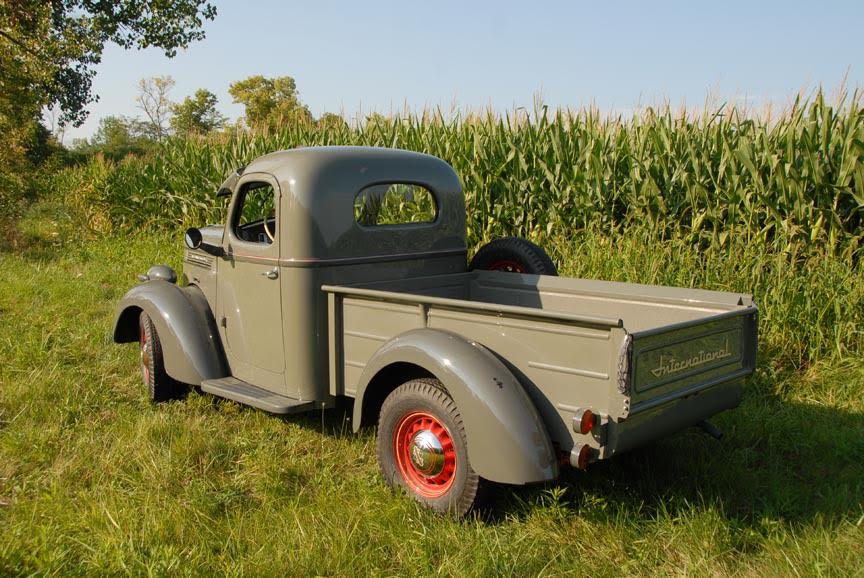Scout Lost Chapter Part 6: IHC D-Line 1937-1940
International Invests In Style

The Lost Chapter series is from Jim Allen and John Glancy's book, International Scout Encyclopedia; one so thorough it couldn't all fit into the final cut. Pre-order the second edition, coming August 1, 2020! Join our mailing list for pre-order specials and exclusive content.
For this series, author and historian Jim Allen is sharing extra material with photographs from John Glancy’s extensive collection as well as photographs from the Wisconsin Historical Society.
The late 1930s were a high point for International Harvester Company trucks from all standpoints. The D-Line debuted in March of 1937 and was every bit as trendy and technically advanced as anything built by the others. The cabs were all steel and roomy enough for three men. These were the first trucks to be worked over at the new test facility for International Harvester Company (IHC) in Fort Wayne, Indiana. This line is also known for being the first time International put a serious amount of energy and effort into styling. These trucks were styled using clay models, just like cars of the day. Because it was the first time International had done that, it resulted in what is considered by many to be the most attractive IHC truck line in the context of its era and market. The late ‘30s D-series truck is often considered to be IHC’s most beautiful and stylish truck. The D-Line and the new K-Line coexisted in 1940. Despite the fact that the K-line was a 1941 model they were introduced very early and were produced in large numbers in 1940.

One interesting tidbit is that the lowest GVW truck did not use the expected D-1 designation. This was to avoid confusion with the previous Willys-sourced D-1. The D-2 and D-5 half-ton line held the bottom GVW, half-ton positions in the lineup. As with the previous C-Line, the D-5 was the “economy” version of the D-2, with a Waukesha 133 ci four-cylinder L-head engine. The D-2 had the option of the “Economy Six,” a 175 ci L-head six (a small bore version of the HD-213) or the 213 ci HD flathead. In this era, the former Willys engine was also enlarged to 232.8 ci via boring and stroking and used in the larger trucks. By this time IHC was fielding some really big stuff too, as well as very stylish COE (Cab Over Engine) DS-300 trucks.
Some of the more interesting SUV-like things to come out of this era were the woody station wagon conversions on the half-ton models. Generally called a Commercial Station Wagon the conversions were done by outside coachbuilders, such as Cantrell, but were an available option through the dealer network. Of course a private individual could have any chassis/cowl IHC truck made into a woody station wagon independent of IHC.
Previous Lost Chapter-Next Lost Chapter
For this series, author and historian Jim Allen is sharing extra material with photographs from John Glancy’s extensive collection as well as photographs from the Wisconsin Historical Society.
The late 1930s were a high point for International Harvester Company trucks from all standpoints. The D-Line debuted in March of 1937 and was every bit as trendy and technically advanced as anything built by the others. The cabs were all steel and roomy enough for three men. These were the first trucks to be worked over at the new test facility for International Harvester Company (IHC) in Fort Wayne, Indiana. This line is also known for being the first time International put a serious amount of energy and effort into styling. These trucks were styled using clay models, just like cars of the day. Because it was the first time International had done that, it resulted in what is considered by many to be the most attractive IHC truck line in the context of its era and market. The late ‘30s D-series truck is often considered to be IHC’s most beautiful and stylish truck. The D-Line and the new K-Line coexisted in 1940. Despite the fact that the K-line was a 1941 model they were introduced very early and were produced in large numbers in 1940.

One interesting tidbit is that the lowest GVW truck did not use the expected D-1 designation. This was to avoid confusion with the previous Willys-sourced D-1. The D-2 and D-5 half-ton line held the bottom GVW, half-ton positions in the lineup. As with the previous C-Line, the D-5 was the “economy” version of the D-2, with a Waukesha 133 ci four-cylinder L-head engine. The D-2 had the option of the “Economy Six,” a 175 ci L-head six (a small bore version of the HD-213) or the 213 ci HD flathead. In this era, the former Willys engine was also enlarged to 232.8 ci via boring and stroking and used in the larger trucks. By this time IHC was fielding some really big stuff too, as well as very stylish COE (Cab Over Engine) DS-300 trucks.
Some of the more interesting SUV-like things to come out of this era were the woody station wagon conversions on the half-ton models. Generally called a Commercial Station Wagon the conversions were done by outside coachbuilders, such as Cantrell, but were an available option through the dealer network. Of course a private individual could have any chassis/cowl IHC truck made into a woody station wagon independent of IHC.
Previous Lost Chapter-Next Lost Chapter

